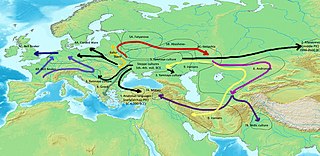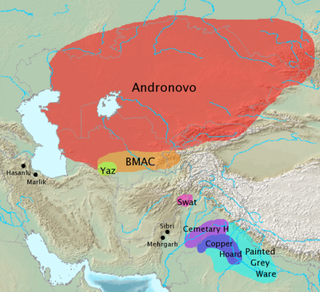
The Bronze Age is a historic period, approximately 3300 BCE to 1200 BCE, that was characterized by the use of bronze, in some areas proto-writing, and other early features of urban civilization. The Bronze Age is the second principal period of the three-age Stone-Bronze-Iron system, as proposed in modern times by Christian Jürgensen Thomsen, for classifying and studying ancient societies and history.
The Iron Age is the final epoch of the three-age division of the prehistory and protohistory of humanity. It was preceded by the Bronze Age and the Stone Age. The concept has been mostly applied to Europe and the Ancient Near East, but also, by analogy, to other parts of the Old World.

A kurgan is a type of tumulus constructed over a grave, often characterized by containing a single human body along with grave vessels, weapons and horses. Originally in use on the Pontic–Caspian steppe, kurgans spread into much of Central Asia and Eastern, Southeast, Western and Northern Europe during the 3rd millennium BC.

A tumulus is a mound of earth and stones raised over a grave or graves. Tumuli are also known as barrows, burial mounds or kurgans, and may be found throughout much of the world. A cairn, which is a mound of stones built for various purposes, may also originally have been a tumulus.

The Kura–Araxes culture, also named Kur–Araz culture, Mtkvar-Araxes culture or the Early Transcaucasian culture was a civilization that existed from about 4000 BC until about 2000 BC, which has traditionally been regarded as the date of its end; in some locations it may have disappeared as early as 2600 or 2700 BC. The earliest evidence for this culture is found on the Ararat plain; it spread northward in Caucasus by 3000 BC.).

The Kurgan hypothesis or Steppe theory is the most widely accepted proposal to identify the Proto-Indo-European homeland from which the Indo-European languages spread out throughout Europe and parts of Asia. It postulates that the people of a Kurgan culture in the Pontic steppe north of the Black Sea were the most likely speakers of the Proto-Indo-European language (PIE). The term is derived from the Russian kurgan (курга́н), meaning tumulus or burial mound.

The Maykop culture, c. 3700 BC–3000 BC, was a major Bronze Age archaeological culture in the western Caucasus region.

Chariot burials are tombs in which the deceased was buried together with their chariot, usually including their horses and other possessions. An instance of a person being buried with their horse is called horse burial.

The Koban culture is a late Bronze Age and Iron Age culture of the northern and central Caucasus. It is preceded by the Colchian culture of the western Caucasus and the Kharachoi culture further east.

The Yaz culture was an early Iron Age culture of Margiana, Bactria and Sogdia. It emerges at the top of late Bronze Age sites (BMAC), sometimes as stone towers and sizeable houses associated with irrigation systems. Ceramics were mostly hand-made, but there was increasing use of wheel-thrown ware. There have been found bronze or iron arrowheads, also iron sickles or carpet knives among other artifacts.

Kurgan stelae or Balbals are anthropomorphic stone stelae, images cut from stone, installed atop, within or around kurgans, in kurgan cemeteries, or in a double line extending from a kurgan. The stelae are also described as "obelisks" or "statue menhirs".

The Prehistory of Siberia is marked by several archaeologically distinct cultures. In the Chalcolithic, the cultures of western and southern Siberia were pastoralists, while the eastern taiga and the tundra were dominated by hunter-gatherers until the late Middle Ages and even beyond. Substantial changes in society, economics and art indicate the development of nomadism in the Central Asian steppes in the first millennium BC.
The Caucasus region, on the gateway between Southwest Asia, Europe and Central Asia, plays a pivotal role in the peopling of Eurasia, possibly as early as during the Homo erectus expansion to Eurasia, in the Upper Paleolithic peopling of Europe, and again in the re-peopling Mesolithic Europe following the Last Glacial Maximum, and in the expansion associated with the Neolithic Revolution.

The Slab Grave culture is an archaeological culture of the Late Bronze Age and Early Iron Age Mongols. According to various sources, it is dated from 1,300 to 300 BC. The Slab Grave Culture became an eastern wing of a huge nomadic Eurasian world which at the beginning of the 1st millennium BC produced a civilization known as Scythian-Siberian. The anthropological type of the population is predominantly Mongoloid, while the western newcomers from the area of Tuva and north-western Mongolia were Caucasoids.

The Leyla-Tepe culture of the South Caucasus belongs to the Chalcolithic era. It got its name from the site in the Agdam district of modern day Azerbaijan. Its settlements were distributed on the southern slopes of Central Caucasus, from 4350 until 4000 B.C.
Begazy-Dandybai culture is Bronze Age culture of mixed economy in the territory of ancient central Kazakhstan, Turkmenistan, and Uzbekistan, dated from the 2nd millennium BCE to 8th century BCE, centered at (Sary-Arka) desert river. The culture, with its megalithic mausolea, flourished between the 12th and 8th centuries BCE. The culture was discovered, first excavated, and published in the 1930s-1940s by M.P. Gryaznov, who took it for a local version of Karasuk culture. In 1979 the Begazy-Dandybai culture was described and analyzed in detail in a monograph by A.Kh. Margulan, who systematically reviewed accumulated material and produced description of the archeological culture. The most famous monuments of Begazy-Dandybai culture are Begazy, Dandybai, Aksu Ayuly 2, Akkoytas, and Sangria 1.3, it was named after the first two archeological sites.
Irmen culture is an indigenous Late Bronze Age culture of animal breeders in the steppe and forest steppe area of the Ob river middle course, north of Altai in western Siberia, dated to around the 9th to 8th centuries BCE. Monuments of this advanced bronze-producing culture include numerous settlements and kurgan cemeteries, the culture was named after Irmen kurgan cemetery now flooded by Novosibirsk reservoir. Irmen culture was discovered and described by N.L.Chlenova in 1970.

The Ingala Valley is an archaeological district in the area between the Tobol and Iset rivers. It is the largest one in the south of the Tyumen Oblast, and belongs to the Iset cultural and historical province. It has 177 kurgans, 55 archaeological sites of federal significance and 5 regional natural monuments.

Alexei Rezepkin is a Russian archaeologist who made some significant archeological discoveries. He is a senior researcher at the Institute of History of Material Culture in St. Petersburg where he lives.
Bronze Age in Azerbaijan began in the second half of the 4th millennium BC and ended in the second half of the 2nd millennium BC, while the Iron Age commenced in approximately 7-6th centuries BC. The Bronze Age in territory of today's Azerbaijan is divided into the early Bronze Age, the middle Bronze Age and the late Bronze Age. Bronze Age was studied in Nakhchivan, Ganja, Dashkasan, Mingachevir, Gobustan, Qazakh and Karabakh.















